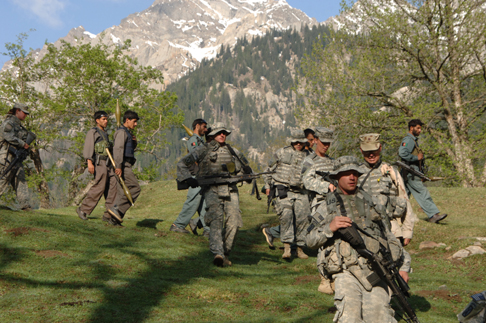|
|
|
US and Afghan troops on patrol in Nuristan. |
A series of airstrikes in northeastern Afghanistan on Sunday killed at least 16 people in what Coalition and Afghan Defense officials said was a deliberate operation against the network of top fugitive warlord Gulbuddin Hekmatyar. The strike occurred in the volatile mountain province of Nuristan, a rugged area north of Kunar long known to be a hotbed of insurgent activity. US and Afghan forces launched Sunday’s attack after intelligence sources revealed Gulbuddin Hekmatyar was in the Dohabi (Doab) district trying to meet with Kashmir Khan, his top military commander, Nuristan’s governor Tamim Nuristani told The Associated Press. The Defense Ministry has since announced Hekmatyar was not the target rather a group of his loyalists who planned on meeting with Nuristani based Taliban fighters.
Afghan commandos and Coalition forces approached the villages of Kendal and Shok during a planned raid against a known insurgent stronghold, according to a US military statement. A major skirmish erupted after the patrol received small-arms fire from insurgents holed up in several compounds. After responding with “accurate small arms fire and crew served weapons,” close air support was called in to destroy the compounds. Several insurgents were arrested and an arms and ammunition dump was recovered following the clash.
Nuristan’s deputy governor, Mohammad Aleem, claimed numerous civilians were killed in the clash, including women and children. Several other Nuristani officials cited the casualty figure around 19 or 20, including women and children, adding local villagers had relayed the figures via radio communications. The remote area where the clash took place has slowed the arrival of Afghan investigators who are still traveling to the scene of the battle.
Both the Afghan Defense Ministry and Coalition officials have denied the reports of civilian casualties. Afghan officials said the raid targeted a suicide-bomb cell and accurate casualty figures would be released following an investigation. At least one Afghan solider was killed in the fighting and three others wounded.
Gulbuddin Hekmatyar runs his own faction of Hezb-i-Islami, a radical Islamist group that is loosely aligned with al Qaeda and the Taliban. Hekmatyar was a key player in the Soviet-Afghan war and led one of the biggest insurgent factions against Soviet and Afghan communists forces. His brutal battlefield tactics and wanton destruction of Kabul following the collapse of the Afghan Communist regime in the early 1990’s led to the demise of Hekmatyar’s popularity. The Taliban overran his last stronghold south of Kabul in 1995 and forced him into exile in Iran from 1996-2002.
His low-profile return to Afghanistan led to a small and temporary alliance with the Taliban before Mullah Omar ultimately ceased cooperation with Hekmatyar’s meager forces. Two groups, however, were created as a merger between local Taliban and Hezb-i-Islami fighters in 2002, Nohzat al-Fath and Lashkar Fedayan-e Islam. Both facilitated training with suicide bombers and improvised explosive devices.
Hekmatyar leads a band of a few hundred loyalists and several senior subcommanders including, Kahsmir Kahan, Haji Eshanullah, Abdul Salam Hashemi, Engineer Obaidullah, and Munshi Abdul Majid. Kashmir Khan, the most notorious of the bunch, is believed to have helped top al Qaeda members escape the Coalition’s air blitz on their Tora Bora Mountain hideout in December 2001. Khan kept a low-profile up until 2006 when he re-emerged as a key insurgent leader in Afghanistan’s northeastern regions.
“The Hezb-i-Islami’s fighting potential has eroded over the years,” Hekmatyar expert Dr. Ishtiaq Ahmad said in an interview with Afgha.com. “The current insurgency is essentially led by the Taliban. However, this does not mean the contribution to this insurgency by Hezb-i-Islami is meaningless. Its renegade commanders still at large such as Kashmir Khan and Obaidullah still pose a threat to Afghanistan, as they are the ones who carry out Hekmatyar’s politically motivated militarism on the ground in alliance with the Taliban.”
Last March, US Special Forces raided a compound owned by Haji Aminullah, a key Hekmatyar commander for Kunar province. The fierce weekend battle left the compound destroyed and an unknown number of insurgents dead.
In May 2002 the CIA narrowly missed assassinating Hekmatyar himself after firing missiles from a remotely piloted drone at a convoy of vehicles thought to be transporting him.










8 Comments
Syed Saleem Shahzad had an article back on April 3 in which he described a significant hit-and-run guerrilla operation by the Taliban. I don’t recall reading about this. Did I just miss it?
Asia Times: Taliban welcome back an old friend
The Thunder Run has linked to this post in the blog post From the Front: 04/08/2008 News and Personal dispatches from the front lines.
More good news from the Afghanistan-Pakistan border area.
Hot Air: U.S. intel: AQ mastermind of London bombings, British airline plot dead
Cables, dispatches and memoranda
Cables, dispatches and memoranda for 4/9/2008…
abu ubaidah survived two american strikes which killed over 100 people, but the info is that eh has died in pakistan tribval area after prolonged illness and buried
Iam relieved that the tenure of G. Tenet is over. He was inept, was not, from wat i read about him, an inspiring, charismatic leader. Gen. Hayes, I hope, and believe, will put the teeth back into CIA. If they missed Hekmatayr, eventually he will be gotten. Maybe CIA should eliminate his people who carry out acts against US forces. If his cronies are dead, that makes him a non-factor. If they are holed up in a walled compound, like in this article, drop a couple 2,000lb bombs, then move in.
As long as Americans use the word “Afghanistan/Pakistan border”, they are not going to FACE FACTS. The fact of the matter is it is Pakistan ONLY.
Hekmatyar was not supported by the CIA during the anti-
Soviet Jihad. Per “the Bear Trap,” All CIA monies had to be funnelled through ISI. ISI distributed the cash to those they thought could forward Pak aims. Hekmatyar got maybe 40% of all funds but that was given by ISI and is admitted as such..after 30% was skimmed for luxury villas and mercedes, that left another 30% for the other 6 parties.
Hekmatyar was and still is ISI’s boy. He lives in Shamshatu Refugee camp near Peshawar. The location of his house is known. ISI meets regularly with him. the fact they continue to protect him is prima facie evidence of Pak profidity in the struggle in S. Asia.